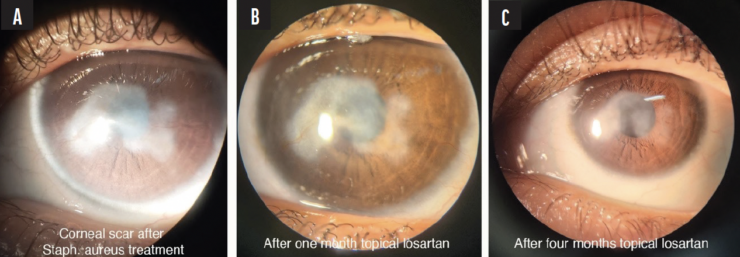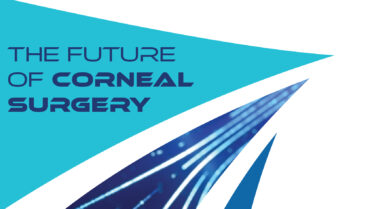
Vision-impairing corneal scarring or fibrosis is a rare but worrisome complication following refractive surgical procedures such as PRK, LASIK, and SMILE. Recent research has highlighted the roles of the epithelial basement membrane (EBM) and Descemet membrane (DM) in modulating the entry of transforming growth factors (TGFs) into the corneal stroma. TGFs are pivotal to the development and resolution of myofibroblasts, which influence the formation of scar tissue. Topical losartan has demonstrated effectiveness for preventing the emergence of myofibroblasts and resolving existing fibrosis by allowing native corneal fibroblasts and keratocytes to reoccupy the scar (unpublished data, 2023).1-4
The primary focus of this article is on complications that arise after refractive surgery. In rabbit models, losartan has shown efficacy for various corneal conditions, including surgical complications, alkali burns, and infection. These findings, detailed in recent reviews and the first reports of off-label human treatment, underscore the drug’s potential to revolutionize the management of corneal fibrosis.5,6
BASIC CORNEAL WOUND HEALING
The EBM and DM modulate the entry of TGF-beta isotypes 1 and 2 into the corneal stroma via the BM components perlecan and collagen type IV.7-9 Normally, little activated TGF-beta 1 or 2 can be detected in the unwounded stroma.10,11 Latent TGF-beta 3 is present in the unwounded stroma and likely contributes to fibrosis once activated after injury or surgery.12
Corneal injury disrupts the EBM and/or DM, allowing an influx of TGF-beta 1 and 2, as well as other cytokines such as platelet-derived growth factor and interleukin-1 while also activating latent TGF-beta 3 within the stroma.12,13 Keratocytes near the site of injury typically undergo apoptosis, initiating wound healing. GFs and cytokines induce some surviving keratocytes to become corneal fibroblasts.13
The EBM is often damaged by surgical procedures such as PRK, LASIK, and SMILE, triggering fibroblast generation. These fibroblasts aid regeneration of the EBM and DM and stromal repair.13,14 After PRK, fibroblasts create a temporary haze by producing disorganized collagens and other extracellular matrix components.10,11 Eventually, fibroblasts either die by apoptosis or revert to keratocytes; corneal transparency is restored as collagens are reabsorbed and restructured.13,14
Persistent EBM damage allows TGF-beta continuous access to the stroma, leading fibroblasts to transform into myofibroblasts. These cells produce abundant disorganized collagens and can cause late haze after PRK or opacity at the edges of the LASIK flap.10,11 Interestingly, fibrosis may resolve if the EBM ultimately regenerates.12
A POTENTIAL THERAPEUTIC AGENT
Losartan disrupts the intracellular TGF-beta signaling pathways at extracellular signal-regulated kinase (ERK), a critical peptide in TGF-beta signaling related to myofibroblast development and survival.5 The drug acts as a BM surrogate. It controls myofibroblast development and promotes the apoptosis of both precursors and mature myofibroblasts until the EBM and/or DM can regenerate or be replaced surgically.
Oral losartan is frequently prescribed for hypertension. This form of the drug does not reach the cornea in sufficient concentrations to affect myofibroblasts.1 Studies in a rabbit model and preliminary human case reports suggest that losartan at concentrations of 0.1 to 0.8 mg/mL in balanced salt solution, pH 7.0, administered six times daily can prevent myofibroblast development or induce apoptosis.1-7 Currently, a concentration of 0.8 mg/mL administered six times daily is favored because it has been used safely off-label in human eyes globally without adverse effects reported.1
REFRACTIVE TREATMENTS AND TOPICAL LOSARTAN
Topical losartan has shown promise for the management of complications after refractive surgery, particularly corneal scarring due to EBM injury. (See the sidebar for a detailed exploration of losartan’s potential application in a wide spectrum of corneal and ocular conditions.)
PRK. The prophylactic application of topical losartan could prevent late haze formation after PRK by initiating apoptosis in myofibroblast precursor cells that depend on TGF-beta.3
Mitomycin C remains my prophylactic agent of choice during PRK because the drug obviates concerns about patient adherence. Should the mitomycin C supply diminish—as has occurred with other drugs—losartan (0.8 mg/mL), administered six times daily for an extended duration, could serve as an effective alternative.
LASIK and SMILE. Surgical complications that lead to scarring may respond to treatment with topical losartan. The first documented case of its use was in an eye that experienced dislocation of the LASIK flap and striae formation, necessitating a flap relift. Significant haze formed following diffuse lamellar keratitis (DLK) treated with corticosteroids that resolved fully after 6 months of losartan therapy.5
In eyes with LASIK buttonhole flaps, fibrosis typically results from EBM injury at the microkeratome’s exit point.14 Notable surface irregularity is often present. Interventions such as phototherapeutic keratectomy and transepithelial PRK, coupled with topical losartan treatment, may be required to restore vision.15
Severe DLK after LASIK or SMILE can result in significant clinical haze,16 which may be alleviated by topical losartan. The drug lacks antiinflammatory properties, so corticosteroids remain the treatment of choice for the DLK inflammation. Adjunctive treatment with losartan, however, can help minimize scarring.
Astigmatic keratotomy and radial keratotomy. Scarring at the incision sites can develop years after radial keratotomy or astigmatic keratotomy. If the fibrosis compromises the patient’s vision, losartan therapy may be beneficial.6
FINAL THOUGHTS
At present, no pharmaceutical companies are producing topical losartan. One reason is that the solution is easily compounded, posing competition to mass production. This might shift pending patent approval. For now, compounding pharmacies are the sole providers of 0.8 mg/mL losartan in balanced salt solution (pH 7.0) for off-label use. Prices range from $90 to $150 per month, excluding shipping, across the United States.
Pure losartan powder rather than crushed tablets must be used for the solution. The latter contain 75% excipients, which may precipitate at losartan concentrations as low as 0.2 mg/mL. The long-term effects of these excipients when used topically remain unknown. The recommended dosage is one drop applied six times daily. Increasing the dosing frequency from four to six times a day has shown effectiveness in cases where the initial regimen failed during a 6-month period. Patients often reported visual improvement before clinical confirmation at the slit lamp, encouraging continued use.
After fibrosis resolves, treatment should continue for several months to allow complete regeneration of the EBM. Recurrent fibrosis after treatment ceases indicates incomplete EBM and/or DM regeneration and warrants restarting losartan therapy. Depending on the pathology, surgical options such as a lamellar or full-thickness corneal transplant, Descemet stripping automated endothelial keratoplasty, or Descemet membrane endothelial keratoplasty may be necessary in some cases to end recurrence of the fibrosis. Similarly, in cases of irreparable structural damage to the cornea, such as severe microbial corneal ulcers, corneal transplantation may still be essential for vision restoration.
Topical Losartan in Diverse Corneal and Ocular Conditions
Beyond the treatment of corneal scarring after refractive surgery, topical losartan has shown or theoretically should show promise for the management of other corneal disorders:1
- Microbial keratitis. Adjunctive therapy with losartan could be beneficial in cases of scarring after microbial keratitis (Figure) or prevention if taken with antibiotics at the time of diagnosis.
- Herpes simplex and zoster keratitis. When administered in conjunction with antivirals, losartan might reduce scarring in cases of recurrent herpes simplex keratitis and herpes zoster keratitis.
- Thermal/chemical burns. Combination therapy with losartan and corticosteroids may reduce scarring from burns by balancing fibrosis control with inflammation management.
- Viral endotheliitis. In eyes with herpes simplex virus endotheliitis, losartan might complement antiviral therapy by addressing posterior corneal fibrosis.
- Endothelial keratoplasty. The application of topical losartan after procedures such as Descemet stripping automated endothelial keratoplasty and Descemet membrane endothelial keratoplasty without endothelial transplantation could reduce the risk of postoperative fibrosis or treat posterior corneal fibrosis that occurs.

Figure. A patient who wore contact lenses presented with a corneal ulcer induced by Staphylococcus aureus. Initial management involved topical antibiotics. The infection resolved, but significant stromal scarring occurred (A). A treatment regimen of 0.8 mg/mL topical losartan administered six times daily was subsequently initiated. Within 1 month, a notable reduction in the corneal opacity was observed (B). A progressive decrease in corneal fibrosis was seen over 4 months of therapy (C).
Courtesy of Rodrigo de Oliveira, MD.
Persistent Epithelial Defects
Stromal changes after PRK can lead to opacity and altered stromal biology.2 Topical losartan has shown the potential to help restore normal stromal function by removing myofibroblasts and encouraging corneal fibroblast or keratocyte repopulation. This mechanism could extend the efficacy of conventional treatments for persistent epithelial defects and possibly augment therapies such as topical nerve growth factor (cenegermin-bkbj ophthalmic solution 0.002% [Oxervate, Dompé]). Concurrent antiviral therapy should be considered if herpes simplex virus is suspected to be an underlying cause.3
Ocular Fibrotic Disorders
Conjunctival fibrosis diseases. Conditions such as Stevens-Johnson syndrome, ocular cicatricial pemphigoid, graft-versus-host disease, and trachoma often lead to corneal scarring. Given losartan’s ability to permeate the full-thickness cornea, therapy with the drug could also have an impact on the conjunctival fibrosis and may be effective against these diseases.4
Glaucoma. Losartan could have a beneficial effect on conjunctival bleb fibrosis and tube shunt encapsulation, both of which are myofibroblast-mediated.
Further clinical trials are essential to explore the drug’s potential applications in corneal and ocular fibrotic disorders.
1. Wilson SE. Topical losartan: practical guidance for clinical trials in the prevention and treatment of corneal scarring fibrosis and other eye diseases and disorders. J Ocul Pharmacol Ther. 2023;39(3):191-206.
2. Wilson SE. Corneal wound healing. Exp Eye Res. 2020;197:109089.
3. Sampaio LP, Martinez VV, Shiju TM, Hilgert GSL, Santhiago MS, Wilson SE. Cell biology of spontaneous persistent epithelial defects after photorefractive keratectomy in rabbits. Transl Vis Sci Technol. 2023;12(5):15.
4. Sampaio LP, Hilgert GSL, Shiju TM, Murillo SE, Santhiago MR, Wilson SE. Topical losartan inhibits corneal scarring fibrosis and collagen type IV deposition after Descemet’s membrane-endothelial excision in rabbits. Exp Eye Res. 2022;216:108940.
1. Sampaio LP, Hilgert GSL, Shiju TM, Murillo SE, Santhiago MR, Wilson SE. Topical losartan inhibits corneal scarring fibrosis and collagen type IV deposition after Descemet’s membrane-endothelial excision in rabbits. Exp Eye Res. 2022;216:108940.
2. Sampaio LP, Hilgert GSL, Shiju TM, Santhiago MR, Wilson SE. Topical losartan and corticosteroid additively inhibit corneal stromal myofibroblast generation and scarring fibrosis after alkali burn injury. Transl Vis Sci Technol. 2022;11(7):9-15.
3. Sampaio LP, Hilgert GSL, Shiju TM, Santhiago MR, Wilson SE. Losartan inhibition of myofibroblast generation and late haze (scarring fibrosis) after PRK in rabbits. J Refract Surg. 2022;38(12):820-829.
4. Sampaio LP, Villabona-Martinez V, Shiju TM, Santhiago MR, Wilson SE. Topical losartan decreases myofibroblast generation but not corneal opacity after surface blast-simulating irregular PTK in rabbits. Transl Vis Res Technol. 2023;12(9):20.
5. Souza ALP, Ambrósio R Jr, Bandeira F, Salomão MQ, Souza Lima A, Wilson SE. Topical losartan for treating corneal fibrosis (haze): first clinical experience. J Refract Surg. 2022;38(11):741-746.
6. Wilson SE. Topical losartan: practical guidance for clinical trials in the prevention and treatment of corneal scarring fibrosis and other eye diseases and disorders. J Ocular Pharmacol Ther. 2023;39(3):191-206.
7. Wilson SE. Coordinated modulation of corneal scarring by the epithelial basement membrane and Descemet’s basement membrane. J Refract Surg. 2019;35(8):506-516.
8. Wilson SE. Defective perlecan-associated basement membrane regeneration and altered modulation of transforming growth factor beta in fibrosis. Cell Mol Life Sci. 2022;79(3):144.
9. Wilson SE, Shiju TM, Sampaio LP, Hilgert GSL. Corneal fibroblast collagen type IV negative feedback loop modulation of TGF beta: a likely fibrosis modulating system in other organs. Matrix Biol. 2022;109:162-172.
10. de Oliveira RC, Tye G, Sampaio LP, et al. TGF1 and TGF2 proteins in corneas with and without stromal fibrosis: delayed regeneration of epithelial barrier function and the epithelial basement membrane in corneas with stromal fibrosis. Exp Eye Res. 2021;202:108325.
11. de Oliveira RC, Sampaio LP, Shiju TM, Santhiago MR, Wilson SE. Epithelial basement membrane regeneration after PRK-induced epithelial-stromal injury in rabbits: fibrotic versus non-fibrotic corneal healing. J Refract Surg. 2022;38(1):50-60.
12. Shiju TM, Sampaio LP, Martinez VV, Hilgert GSL, Wilson SE. Transforming growth factor beta-3 localization in the corneal response to epithelial-stromal injury and effects on corneal fibroblast transition to myofibroblasts. Exp Eye Res. 2023;235:109631.
13. Wilson SE. Corneal wound healing. Exp Eye Res. 2020;197:109089.
14. Wilson SE. The corneal fibroblast: the Dr. Jekyll underappreciated overseer of the responses to stromal injury. Ocul Surf. 2023;29:53-62.
15. Kapadia MS, Wilson SE. Transepithelial photorefractive keratectomy for treatment of thin flaps or caps following complicated laser in situ keratomileusis. Am J Ophthalmol. 1998;126(6):827-829.
16. Reinstein DZ, Stuart AJ, Vida RS, Archer TJ, Carp GI. Incidence and outcomes of sterile multifocal inflammatory keratitis and diffuse lamellar keratitis after SMILE. J Refract Surg. 2018;34(11):751-759.


